

Zitierweise / cite as:
Payer, Alois <1944 - >: Chronik Thailands = กาลานุกรมสยามประเทศไทย. -- Chronik 2000 / B. E. 2543. -- 1. undatiert. -- Fassung vom 2017-03-20. -- URL: http://www.payer.de/thailandchronik/chronik2000a.htm
Erstmals publiziert: 2012-10-27
Überarbeitungen: 2017-03-20 [Ergänzungen] ; 2016-11-21 [Ergänzungen] ; 2016-11-14 [Ergänzungen] ; 2016-08-23 [Ergänzungen] ; 2016-04-22 [Ergänzungen] ; 2016-04-11 [Ergänzungen] ; 2016-03-01 [Ergänzungen] ; 2016-02-12 [Ergänzungen] ; 2016-01-19 [Ergänzungen] ; 2015-09-04 [Ergänzungen] ; 2015-08-13 [Ergänzungen] ; 2015-05-25 [Ergänzungen] ; 2015-04-20 [Ergänzungen] ; 2015-04-15 [Ergänzungen] ; 2014-10-06 [Ergänzungen] ; 2014-09-23 [Ergänzungen] ; 2014-09-16 [Ergänzungen] ; 2014-09-09 [Ergänzungen] ; 2014-08-27 [Ergänzungen] ; 2014-04-07 [Ergänzungen] ; 2014-03-23 [Ergänzungen] ; 2013-09-26 [Ergänzungen] ; 2013-05-02 [Ergänzungen] ; 2013-04-26 [Teilung des Jahrgangs]; 2013-04-21 [Ergänzungen]; 2013-04-09 [Ergänzungen]; 2013-03-30 [Ergänzungen]; 2013-03-19 [Ergänzungen]; 2013-03-09 [Ergänzungen]; 2013-03-02 [Ergänzungen]; 2013-01-30 [Ergänzungen]; 2013-01-13 [Ergänzungen]; 2012-11-12 [Ergänzungen]
©opyright: Dieser Text steht der Allgemeinheit zur Verfügung. Eine Verwertung in Publikationen, die über übliche Zitate hinausgeht, bedarf der ausdrücklichen Genehmigung des Herausgebers.
Dieser Text ist Teil der Abteilung
Thailand von
Tüpfli's Global Village Library
ช้างตายทั้งตัวเอาใบบัวปิดไม่มิด
|
Gewidmet meiner lieben Frau Margarete Payer die seit unserem ersten Besuch in Thailand 1974 mit mir die Liebe zu den und die Sorge um die Bewohner Thailands teilt. |
|
Bei thailändischen Statistiken muss man mit allen Fehlerquellen rechnen, die in folgendem Werk beschrieben sind:
Die Statistikdiagramme geben also meistens eher qualitative als korrekte quantitative Beziehungen wieder.
|
| Statistik: Einwohner (Volkszählung): 60.916.441 Lebenserwartung Männer: 69, 9 Jahre Lebenserwartung Frauen: 74,9 Jahre Bruttonationalprodukt: 4.922.731 Mio. Baht Durchschnittliches jährliches Pro-Kopf-Einkommen: 58.146 Baht Durchschnittlicher Kunstdüngerverbrauch pro Hektar: 86 kg Durchschnittlicher Pestizidverbrauch pro Hektar: 1 kg Durchschnittliche Arbeitskräfte pro Hektar Ackerland: 1,2 Landwirtschaftliche Traktoren: 200.000 Erfasste Drogenvergehen: 429 pro 1000.000 Einwohner Einwohner mit Verbindung zu ehemaligen Kuomintang-Truppen (中國國民黨): ca. 20.000 in 84 Dörfern Nordthailands Ausländische Touristen: 9,5 Mio. Thais in den USA: 150.000 Morde mit Schusswaffen: 20.000 Morde mit Schusswaffen pro 100.000 Einwohner: 33 Todesfälle deutscher Touristen: 120 Umsatz der Comic-Industrie pro Jahr: 3 Milliarden Baht Neue Comic-Titel pro Woche: 35 bis 50 Kosten eines in Thailand gedruckten Comic: 5 Baht Kosten eines aus Japan importierten Manga: 35 Baht Funkamateure: 141.000 |
2000
Die Regierung setzt das verbesserte System zur Wiedergabe von Thai-Wörtern in lateinischen Buchstaben in Kraft
"ROMANIZATION SYSTEM FOR THAI BGN/PCGN 2002 Agreement
This system was developed by the Royal Institute of Thailand. It was officially endorsed by the government of Thailand in 2000 and approved for use by the United Nations in 2002. The system is a revised version of the 1967 Royal Institute of Thailand system previously used by BGN and PCGN. This revision principally affects vowels, where additional romanizations have been introduced to provide further differentiation. Indications of vowel length and tone are not included in the system.
Word boundaries are not ordinarily shown in Thai writing. Characters are not always written in the sequence in which they should be romanized. Characters which are phonologically superfluous, and characters which indicate tone, should not be romanized.
Since correct identification of the words which appear in any particular name and knowledge of their correct pronunciation are essential in the romanization of Thai, each word should be verified in a dictionary of pronunciation, or the name should be verified in an official Thai place names document which provides Roman-script spellings.
CONSONANT CHARACTERS
For some consonant characters, two different Roman equivalents are shown in the table. The first equivalent is for use in syllable-initial position and the second is for use in syllable-final position. The Thai characters ฉ and ฌ (row 4), ผ (row 12), ฝ (row 13), ซ (row 19), and ฮ (row 20) do not appear at the end of syllables in Thai words.
Thai Romanization (See note 1. ) Notes Syllable - initial Syllable - final 1. ก k k 2. ฃ ฆ ค ฅ* ฃ* kh k 3. ง ng ng 4. จ ฉ ซ ฌ ch t 5. ญ y n 6. ฎ ฑ7ด d t 7. ฏ ต t t 8. ฐ ฑ7 ฒ ถ ท2 ธ th t 9. ณ น n n 10. บ b p 11. ป p p 12. ผ พ ภ ph p * rare or obsolete character
Thai Romanization (See note 1. ) Notes Syllable - initial Syllable - final 13. ฝ ฟ f p 14. ม m m 15. ย y y (See the vowel table, rows 9-14 and 20. ) 16. ร2 r n 17. ล ฬ I n 18. ว3 w w (See the vowel table, rows 14-20. ) 19. ซ ศ ษ ส s t 20. ห4 ฮ h h 21. อ5 (See the vowel table, rows 8 and 12-15, and note 6. ) VOWEL CHARACTERS
Each ◌ shown below represents a Thai consonant character.
Thai
Romanization 1. ◌ะ ◌า ◌1 a 2. am 3. ิ ี i 4. ุ ู u 5. ึ ื ือ ue 6. เ◌ เ◌ะ เ็◌ e 7. แ◌ แ◌ะ แ็◌ ae 8. โ◌ โ◌ะ เ◌าะ ◌อ ◌1 o 9. เ◌อ เ◌อะ เิ◌ oe 10. เีย เียะ ia 11. ใ◌ ไ◌ ัย ไ◌ย ◌าย ai 12. ุย ui 13. โ◌ย ◌อย oi
Thai
Romanization 14. เ◌ย oei 15 ัวย uai 16. เือย ueai 17. ัวะ ัว ◌ว◌3 ua 18. เือ เือะ uea 19. เ◌า ◌าว ao 20. ิว io 21. เ◌ว เ็ว eo 22. แ็ว แ◌ว aeo 23. เียว iao 24. ฤ rue, ri,roe (according to pronunciation)
25. ฤา rue 26. ฦ ฦา lue
Tone Marks Vowel Shortening Mark ่ ้ ๊ ๋ (See note 9) ็ (See note 9. )
Silencing Mark Reduplicating Mark ์ (See note 8. ) ๆ (See note 10. )
NUMERALS ๐ ๑ ๒ ๓ ๔ ๕ ๖ ๗ ๘ ๙ 0 1 2 3 4 5 6 7 8 9 *
rare or obsolete characterNOTES
- A Thai consonant character with no accompanying vowel mark or diacritical mark may be romanized with the vowel letter a or o: ปฐม → pathom, พลบ → phlop. Pronounced consonants and vowels which are omitted in Thai writing should be reflected in romanization: ศิลปะ → sinlapa, ทัศนะ → thatsana.
When a single consonant character represents both the final consonant of one syllable and the initial consonant of the next syllable, both consonants should be reflected in romanization: ศักราช → sakkarat; ราชสีห์ → ratchasi. Consonant and vowel characters written in misleading order should be romanized as pronounced: แขนง → khanaeng; เขย่า → khayao; but note: เทวา → thewa.
- ทร may be romanized s, thora, or thr at the beginning of a word, according to pronunciation: ทราย → sai, ไทร → sai, ทรราช → thorarat, ทรัส → thrat; but note: ที่ราบ → thirap. At the end of a word, ทร should be romanized thon (ศุนทร → sunthon) or, if silent 5 should not be romanized.
รร
should generally be romanized a or an: กรรม 一 kam; กรรไกร 一 kankrai; but note: กรรมการ → kammakan.ร
should not be romanized, if silent: จริง → ching; สามารถ → samat; but note: จริต → charit.Otherwise, ร at the beginning of a syllable, whether or not preceded in the same syllable by a character from the consonant table, row 1, 2, 7, 8, 11, or 12, should generally be romanized r: รักแรก → rakraek, ตระการ → trakan. At the end of a syllable, ร should generally be romanized n or on: ควร → khuan, นคร → nakhon.
- ว at the beginning of a syllable should be romanized w: วงเวียน → wongwian. Between two consonant characters in a single syllable, ว should be romanized either ua or w: จวง → chuang, ควน → khwan. See the vowel table, rows 14-20.
- ห at the beginning of a syllable and serving as a tone mark should not be romanized: หวอ → wo, หลืบ → luep; otherwise, ห should be romanized h: หวย 一 huai; โวหาร 一 wohan.
- อ at the beginning of a syllable generally represents a glottal stop followed by a vowel: อรุณ → arun; less frequently it serves as a tone mark: อยาก → yak. In both instances, อ should not be romanized. See the vowel table, rows 4, 7, 8, and 12-15.
- In romanized forms where a syllable ending with a vowel is followed by a syllable beginning with a vowel, a hyphen should be inserted at the syllable boundary: ไปรษณีย์อากาศ → praisani-akat, อายุอานาม → ayu-anam. A hyphen should also be inserted between the two consonant letters in the sequences kh, ph, and th, if those letters belong to different syllables: สิบหก → sip-hok, ลูกเห็บ→ luk-hep. (See also note 11. )
- The rare character ฑ at the beginning of a syllable is romanized th or d, depending on pronunciation: นาฑี → nathi, บัณฑิต → bandit.
- The silencing mark ์ written over the final character of a word, together with the vowel and/or consonant character(s) to which the mark applies, should not be romanized: กรรมสิทธิ์ → kammasit, พระอินทร์ → Phra-in.
- The vowel shortening mark ็ and the tone marks ่, ้, ๊, and ๋ should not be romanized: ก็ → ko, ยี่ห้อ → yiho, กระต๊อบ → kratop. See the vowel table, rows 5, 6, and 18.
- The reduplicating mark ๆ indicates repetition of a syllable: ไหน → nai, ไหนๆ → nainai.
- In multi-syllable words, the final character of the preceding syllable and the initial character of the succeeding syllable may cause reading ambiguity. Therefore, a hyphen is used for syllable separations according to the following rules:
- A hyphen is inserted when the final character of the preceding syllable is a vowel and the initial character of the succeeding syllable is ng (ง), e. g., สง่า Sa-nga.
- A hyphen is inserted when the final character of the preceding syllable is ng (ง) and the initial character of the succeeding syllable is a vowel, e. g., บังอร → Bang-on.
- A hyphen is inserted when the initial character of the succeeding syllable is a vowel, e. g., สะอาด → sa-at, สำอาง → sam-ang.
- Words followed by paiyannoi (ฯ), which shortens forms of a well-known word or words, are written out in full according to the reading rules, e. g., กรุงเทพฯ → Krung Thep Maha Nakhon Bangkok (Bangkok).
- One must bear in mind that the romanization of Thai in this case employs the transcription method. Thus, tone marks ( ่, ้, ๊, and ๋) and diacritical marks including the silencing mark (์) and the vowel shortening mark (็) are completely ignored. In order to transcribe Thai words correctly one must know how to read and pronounce them. There are many words that carry a character or characters that are not pronounced, such as สามารถ → samat (ร is silent), พรหม → Phrom (ห is silent), ลักษณม์ lak (ษณม์ are silent), ธาตุ that (ุ is silent), อินทรธณู inthanu (ทร are silent), and there are also a number of words in Thai where a syllable with an intruding vowel [a] must be inserted such as ปรารถนา → pratthana (ร is silent and [tha] is inserted), and รัตนา → rattana ([ta] is inserted) when pronouncing them.
- When using geographical names romanized according to the previous 1967 version of the official Thai romanization system, it is essential to know that earlier no distinction was made between the vowels u and ue (u was used in both cases) and some diphthongs were romanized differently (iu for the character now romanized as io, ieo for the character now romanized as iao)."
[Quelle: http://geonames.nga.mil/gns/html/Romanization/Romanization_Thai.pdf. -- Zugriff am 2015-08-13]
1960 - 2000
Müttersterblichkeit:
Abb.: Müttersterblichkeit 1960 - 2000
[Bildquelle: Nachrichten aus der ärztlichen Mission / Difäm. -- 2 (2012). -- S. 4]
1987 - 2009
Geburten unter Aufsicht von medizinischem Fachpersonal
Abb.: Prozentsatz der Geburten unter Aufsicht von medizinischem Fachpersonal 1987 - 2009
[Datenquelle: http://www.indexmundi.com/facts/thailand/births-attended-by-skilled-health-staff. -- Zugriff am 2014-04-07]
1984 - 2000
Kinderarbeit unter 15jähriger
Abb.: Kinderarbeit unter 15jähriger, 1984 - 2000 (in Prozent der Altersgruppe)
[Datenquelle: Siroj Sorajjakool <1959 - >: Human trafficking in Thailand : current issues, trends, and the role of the Thai government. -- Chiang Mai : Silkworm, 2013. -- 241 S. : 21 cm. -- ISBN 978-616-215-060-9. -- S. 108.]
1984 - 2000
Jugendarbeit
Abb.: 15- bis 19jährige als Arbeitskräfte (in Prozent), 1984 - 2000
[Datenquelle: Siroj Sorajjakool <1959 - >: Human trafficking in Thailand : current issues, trends, and the role of the Thai government. -- Chiang Mai : Silkworm, 2013. -- 241 S. : 21 cm. -- ISBN 978-616-215-060-9. -- S. 109.]
1988 - 2010
Militärausgaben:
Abb.: Militärausgaben 1988 - 2010 in Milliarden Baht (blau) und in Promille des Bruttosozialprodukts (rot). Datenquelle: SIPRI
1991 - 2009
Jährliche Produktion an Thai-Kinofilmen 1991 - 2009
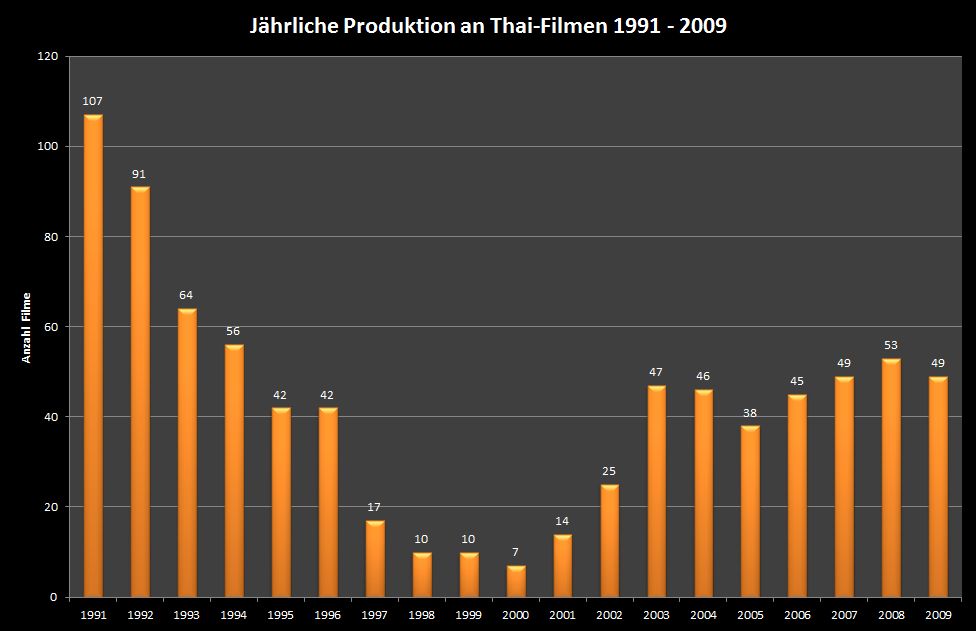
Abb.: Jährliche Produktion an Thai-Kinofilmen 1991 -
2009
[Datenquelle:
Raksarn Wiwatsinudom (รักศานต์ วิวัฒน์สินอุดม), 2011]
um 2000

Slogan auf vielen Plakatwänden:รักไนหลวง ห่วงลูกหลาน ร่วมกันต้านยาเสพติด - "Liebe den König, sei besorgt um die kommenden Generationen, gemeinsam gegen Drogen!"
2000
Nach Angaben des Thai Farmers Research Center konsumieren Arbeiter Ya Ba [ยาบ้า] jährlich im Wert von 100 Mio Baht. In Bangkok allein wird jährlich Ya Ba [ยาบ้า] im Wert von insgesamt 1 Milliarde Baht pro Jahr vermarktet.
2000

Beginn der Milch-Fluoridierung in Bangkok, gefördert durch die britische Borrow Foundation
"As part of the Thai government’s commitment to the health and welfare of children, a long established national scheme provides milk free of charge to school children across the country. This offered an excellent opportunity to introduce milk fluoridation in the city of Bangkok in the year 2000. The programme has since been extended to eleven other provinces:
- Khon Kaen [ขอนแก่น],
- Chumphon [ชุมพร],
- Surat Thani [สุราษฎร์ธานี],
- Chonburi [ชลบุรี],
- Sra Kaew [สระแก้ว],
- Krabi [กระบี่],
- Phatthalung [พัทลุง],
- Trang [ตรัง]
and most recently to
- Pattani [ปัตตานี],
- Yala [ยะลา] and
- Narathiwat [นราธิวาส].
Abb.: Lage der genannten Provinzen
[Bildquelle: CIA. -- Public domain]There are now 1,300,000 children aged 3 – 12 years drinking fluoridated milk across the country.
Responsibility for the schemes rests with the respective provincial health authorities. The Department of Health, Ministry of Public Health, is central to the development of the programme, providing guidance and support for scheme implementation.
The Department of Health also works closely with the Food and Drug Administration, and with the Royal Chitralada Projects, to monitor compliance.
The Royal Chitralada Projects has had a vital role in the development of the programme. From the outset, fluoridated milk for the scheme in Bangkok has been supplied by this unique centre for agricultural and research development, initiated by His Royal Highness King Bhumibol Adulyadej in the grounds of the Chitralada Palace in the city.
Staff there have gained considerable expertise in the production of fluoridated milk and in quality control. Their skills have enabled them to provide essential technical support to the Department of Health, and to the 20 dairies to date that have become engaged in the programme as it has evolved. Their knowledge has also been applied to the development of proposals for similar interventions in other countries.
An interesting aspect of the programme in Thailand is that fluoridated UHT milk has been used. This was first produced in Khon Kaen by the Dairy Producers’ Organisation of Thailand (DPO). The use of this long-life product facilitated the local expansion of the programme.
Good communication has been ensured through a national network group which was formed in 2008. This forum has proved to be invaluable in strengthening the programme and its role is becoming ever more important as milk fluoridation grows in Thailand."
[Quelle: http://www.borrowfoundation.org/milk-fluoridation-programmes/current-programmes.html. -- Zugriff am 2016-04-22. -- Fair use]
2000
Erpresserbrief der Patani Malay National Revolutionary Front:
Abb.: Erpresserbrief, 2000
[Bildquelle: Abuza, Zachary: Conspiracy of silence : the insurgency in southern Thailand. -- Washington, DC : United States Institute of Peace Press, 2009. -- 293 S. ; 23 cm. -- ISBN 9781601270023. -- S. 255. -- Fair use]Übersetzung:
"[Islamic Script]
BRN Congress [Barisan Revolusi Nasional]
[Islamic Script]
Patani Malay National Revolutionary Front
[Symbol]Buddhist Era 2543/25/199
Letter No. 619Dear Sir, Madam:
Goodwill.
I would like to inform you as follows:
- As you have assets and income, I would like you to contact us (BRN) urgently to pay a per person tax and an income tax in the amount of Bt600,000.
- If you ignore or refuse, we will send the commandos to destroy you, your family, and your property everlasting.
I hope you understand it.
Goodwill and nonviolence.
From — ABRIP
Warning —
If this document has been changed, I am not responsible.
Representative —1. Pohmah Suhaibatu ( [signature] )
2. ( [signature] )"
[Quelle: Abuza, Zachary: Conspiracy of silence : the insurgency in southern Thailand. -- Washington, DC : United States Institute of Peace Press, 2009. -- 293 S. ; 23 cm. -- ISBN 9781601270023. -- S. 254. -- Fair use]
2000
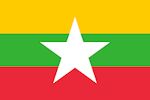
Thai Autoritäten schätzen, dass die UWSA (United Wa State Army (佤邦联合军 / ဝပြည် သွေးစည်းညီညွတ်ရေး တပ်မတော်) und ihre Affillierten ca 50 Drogenlaboratorien betreibt,, viele davon in der Umgebung von Mong Yawn.
Abb.: Lage von Mong Yawn
[Bildquelle: OpenStreetMap. -- Creative Commons Lizenz (Namensnennung, share alike)]
2000
Gründung von Lesla. Gründerin ist die Tom (ทอม) Manthana Adisayathepakul (มัณฑนา อดิสยเทพกุล). Lesla ist ein Verein homosexueller Frauen (Selbstbeschreibung: "biggest Thai lesbian community), gibt eine Mitgliederzeitschrift heraus und ist im Internet präsent.
Abb.: ®Logo
[Fair use]Manthana versucht auch, das westliche Verständnis von Lesbe populär zu machen:
"Lesla’s founder, Manthana [มัณฑนา], has used the WebBoard as a forum for challenging the rigid gender hegemony of tom and dee [ทอม, ดี้]. Manthana is a tom [ทอม], has a clearly masculine appearance, and is very much part of the Bangkok tom-dee scene. However, she has criticized the rules that toms, and dees uphold. In particular, Manthana has challenged the idea that dees [ดี้] do not and should not perform sexually for toms. Manthana has also tried to popularize the Western concept of "lesbian": "Lesbians [เลสเบียน] are women who love women, and toms are women. A tom who loves a woman or another tom is normal, but toms in Thailand have been put under the control of rules that do not allow toms to take off their clothes. Dees don’t have to do anything in return, and toms understand that they have to be like men. They are therefore ashamed to take off their clothes in front of anybody else. Dees who haven’t done anything to their tom, ask yourself, if you really love your tom, why don’t you like to make her have the pleasure that you get from her?"
The most popular topic for discussion on the WebBoard is the meaning of being tom or dee. Members ask for advice, express their opinions, and joke and flirt with each other. One member stated that toms are "lesbians" too, but they are ashamed of their female body, since they would prefer to be men. Another member told of her sense of gender transformation as she switched from dee partners to a tom partner:
"I used to think that I was the tom of the year because I am so manly. One day I fell in love with another tom. At first I was scared and felt strange. I was afraid that I was transforming (klai-rang) [กลายรัง] into a dee or slowly becoming a woman. The first time we had sex, I felt very shy, but I slowly learned that I was still a woman who loved women like before. I was still myself, still able to hit the punching bags as before. Why do I have to be categorized as tom or dee or lesbian? I am still a woman who loves women."
In an interview, Manthana said ideas of gender within the tom-dee community needed to be changed:
"Actually I met some toms and dees in their early twenties. They believe in one way, but in their bed they take turns. [Laughs.] But they don’t let anybody know, because they have been taught that if you are a tom, you can’t let anyone do you and you have to be active only. Once you let someone do you, you will become a dee. That’s why I’m trying to work on this point to make people accept two-way [sex]. Even on the WebBoard I usually tell them that if you are a woman who loves a woman, you are a lesbian, no matter if you are a tom or a dee, because you are physically a woman, and you don’t want people to tell you how to act or dress" (English and Thai used).
[Quelle: Sinnott, Megan J.: Toms and dees : transgender identity and female same-sex relationships in Thailand. -- Honolulu : University of Hawaii Pr., 2004. -- 261 S. : Ill. ; 24 cm. -- ISBN 0824828526. -- Zugl. Diss., Univ. of Wisconsin - Madison, 2002. -- S. 175f.]
2000
Es erscheint
อาคม เดชทองคำ [Akhom Detthongkham]: หัวเชือกวัวชน [Kampfstiere und ihre Halter]. -- กรุงเทพฯ : สำนักงานกองุทนสันบสุนนการิวัจย, 2543 [=2000]. -- 282 S. : Ill. ; 22 cm. -- ISBN 9789748196879
Abb.: Einbandtitel der 2. Auflage, 2004
"In 2000 Arkhom Detthongkham [อาคม เดชทองคำ] from Nakhon Sri Thammarat’s Ratchabhat College [มหาวิทยาลัยราชภัฏนครศรีธรรมราช] published an ethnographic study of the culture of bull-fighting in southern Thailand. The study is a model of what local studies should be. capturing the "flavor" of the aggressive masculine culture of the south through the metaphor of the bull-fight (Arkhom 2000). The research was picked up by the national media - this was a time when the southern-dominated Democrats Party [พรรคประชาธิปัตย์] was in government - and within days Arkhom was forced into hiding following threats by local influential figures against what was interpreted as the study’s denigration of southern Thai culture. Here it is not the state, the traditional villain, but local politicians with otherwise prominent roles in the narrative of democratization and decentralization of the 1980s and 1990s who are setting the limits to intellectual freedom." [Quelle: Jory, Patrick: Problems in contemporary Thai nationalist historiography. -- In: Kyoto Review of Southeast Asisa. -- 3 (2003-03). -- Online: https://www.academia.edu/7076748/_Problems_in_Contemporary_Thai_Nationalist_Historiography_. -- Zugriff am 2016-02-12. -- Fair use]
2000
Es erscheint
ไชยัรต์น เจิรญิสนโอฬาร [Chairat Charoensin-o-larn] <1949 - >: วาทกรรมการพัฒนา : อำนาจ ความรู้ ความจริง เอกลักษณ์ และความเป็นอื่น = Development discourse : power, knowledge, truth, identity and otherness. -- กรุงเทพฯ : , 2543 [=2000]. -- 437 S : Ill. ; 12 cm
Abb.: Einbandtitel der 5. Auflage
"Chairat Charoensinolan’s [ไชยัรต์น เจิรญิสนโอฬาร, 1949 - ] study of the discourse of development (2000) has been the most influential work in recent years on the history of Thai economic development. Chairat also uses Foucault [Paul-Michel Foucault, 1926 - 1984] to criticize western discourses of development that have dominated economic thinking and policy making since the first Economic and Social Development Plan of 1961." [Quelle: Jory, Patrick: Problems in contemporary Thai nationalist historiography. -- In: Kyoto Review of Southeast Asisa. -- 3 (2003-03). -- Online: https://www.academia.edu/7076748/_Problems_in_Contemporary_Thai_Nationalist_Historiography_. -- Zugriff am 2016-02-12. -- Fair use]
2000
Es erscheint die angeblich erste Studie eines Thai-Wissenschaftlers über Tai außerhalb Thailand:
ยศ สันตสมบัติ [Yos Santasombat]: หลักช้าง : การสร้างใหม่ของอัตลักษณ์ไทในใต้คง. -- กรุงเทพฯ : มูลนิธิวิถีทรรศน์, 2543 [= 2000]. -- 258 S. : ill. ; 22 cm. -- ISBN 974-7883-14-7
Abb.: EinbandtitelEnglische Übersetzung:
Yos Santasombat [ยศ สันตสมบัติ]: Lak Chang : a reconstruction of Tai identity in Daikong. -- [2. ed.]. -- Canberra : ANU, 2008. -- 181 S. : Ill ; 23 cm. -- ISBN 978-1-9215-3638-0. -- Originaltitel: หลักช้าง : การสร้างใหม่ของอัตลักษณ์ไทในใต้คง (2000)
Abb.: Einbandtitel
2000

Die Heinrich-Böll-Stiftung von Bündnis 90/Die Grünen eröffnet ein Südostasien-Regionalbüro in Chiang Mai (เชียงใหม่), 2010 verlegt sie das Büro nach Bangkok.
Abb.: ®Logo
"Schwerpunktmäßig arbeitet das Südostasien-Regionalbüro in den Bereichen Demokratisierung sowie Ökologie und nachhaltige Entwicklung.
In Thailand stehen derzeit Projekte und Aktivitäten in drei Feldern im Fokus:- Demokratische Medien
Das Medienprogramm des Regionalbüros zielt auf Informationsdemokratie in Thailand. Es unterstützt Partnerinnen und Partner, die sich für entsprechende Medienreformen einsetzen, und es trägt zur Erweiterung und Stärkung von Netzwerken lokaler thailändischer Radiostationen und Internet-basierter alternativer Kommunikationskanäle bei. Vor allem Letztere kamen in den vergangenen Jahren verstärkt in Kontakt mit dem kontrovers diskutierten Computerkriminalgesetz von 2007.
- Nachhaltige Energiepolitik und Klimawandel
Die Heinrich-Böll-Stiftung konzentriert sich in Thailand auf die Förderung einer nachhaltigen Energiepo
litik im Zeichen des Klimawandels. Wichtige Themen in Thailand sind die Förderung Erneuerbarer Energien und von Energieeffizienz, die Demonopolisierung des Energiesektors, Aufklärungsarbeit über Risiken und Gefahren der Atomkraft sowie die Entwicklung angemessener Antworten auf die Bedrohung des Klimawandels. Das Büro in Bangkok verschränkt dabei seine Arbeit vor Ort mit den klima- und energiepolitischen Strategien der Berliner Zentrale.
- Geschlechterpolitik und Stärkung der politischen Teilhabe von Frauen
Geschlechterpolitik ist Thema in allen Programmen des Regionalbüros. Das heißt, Veranstaltungen und Projektaktivitäten werden mit Sensibilität für ihre spezifische Relevanz für Frauen und Männer konzipiert. Genderperspektiven werden systematisch in die Vorhaben eingearbeitet. Die Projektpartnerinnen und -partner werden mit Fortbildungen, Materialien und Netzwerken unterstützt.Die
Myanmar-Programmarbeit wird derzeit noch vom Bangkoker Regionalbüro gesteuert und umfasst zwei Programmschwerpunkte zur Unterstützung von politischem und gesellschaftlichem Wandel im Land:
- Ressourcenpolitik und Entwicklung
- Politische Kultur/Demokratieförderung
Seit 2004 werden außerdem junge Führungskräfte aus unabhängigen Organisationen aus Myanmar für das internationale M.A. Stipendienprogramm der Heinrich-Böll-Stiftung in Thailand rekrutiert. Ausbildungsstätten sind die Chulalongkorn Universität in Bangkok für das M.A. Programm „Internationale Entwicklungsstudien“ (MAIDS), sowie das Regionalzentrum für Nachhaltigkeitsstudien zu „Nachhaltigem Umwelt- und Ressourcenmanagement" (RCSD) an der Chiang Mai Universität. .
Im Zuge des Starts der ASEAN Economic Community (AEC) dehnt das Regionalbüro in Bangkok seine Arbeit ab 2015 verstärkt auf den stetig an Bedeutung gewinnenden ASEAN-Raum aus."
2000
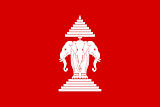

Es erscheint:
Quincy, Keith: Harvesting Pa Chay's wheat : the Hmong and America's secret war in Laos. -- Spokane : Eastern Washington Univ. Pr., 2000. -- 597 S. : Ill. ; 23 cm. -- ISBN 0910055602
Abb.: Einbandtitel
2000

Es erscheint:
Darin untersucht Jackson die Entwicklung der Bezeichnungen für Homosexuelle Männer und Frauen in Thailand von 1960 - 1985.Jackson, Peter A.: An explosion of Thai identities : global queering and re-imaging queer theory. -- In: Culture, health and sexuality. -- Vol. 2. No.4 (2000). -- S. 405 - 424
z.B. von
- ดี้ (dee = Abkürzung für engl. "Lady")
- ทอมดี้ (tom-dee = "Lady-Tom")- Lesbe
- เสือไบ ("Bi-Tiger") - bisexueller Mann
Z.B. hat sich die Bezeichnung für Transsexuelle (Kathoey - กะเทย) aufgespalten in:
- kathoey thae (กะเทยแท้ - "echter Kathoey"): Hermaphrodit
- kathoey thiam (กะเทยเทียม - "falscher Kathoey"): Transvestit
- kathoey sao (กะเทยสาว - "Fräulein-Kathoey"): junge weibliche Transvestitin
- krathiam (กระเทียม - "Knoblauch"): Homosexueller, der sich zu Männern hingezogen fühlt, der kein Transvestit ist
- kathoey num (กะเทยนุ่ม - "zarter Kathoey"): junger männlicher Homosexueller
- kathoey phuchai (กะเทยผู้ชาย - "männlicher Kathoey"): erwachsener männlicher Homosexueller
- Kathoey phraphet song (กะเทยประเภทสอง - "Kathoey zweiter Kategorie"): Homosexueller, der Männer bevorzugt, aber kein Transvestit ist
2000

Es erscheintNostitz, Nick <1968 - >: Patpong, Bangkok's twilight zone : a photographic diary. -- London : Westzone, 2000. -- Ohne Seitenzählung : Ill. ; 27 cm. -- ISBN 0-9537438-2-9
Abb.: Umschlagtitel
[Fair use]
"Nick Nostitz (born 1968) is the professional name of Nikolaus Freiherr von Nostitz - a German photographer who is a member of the Silesian Nostitz family. He has lived and worked in Bangkok since 1993. Fluent in the Thai language, Nostitz is noted for specializing in what he considers to be the "lower levels" of the country's society seldom seen by casual visitors. Nostitz used black-and-white photographs to depict the both allure and sadness connected with the Thai sex industry in his 2001 book Patpong: Bangkok's Twilight Zone (ISBN 0-9537438-2-9). In 2004 he documented the violent war of then Prime Minister Thaksin Shinawatra against alleged drug dealers with a series of photographs. His work has appeared in several leading European magazines, such as Stern and Der Spiegel.
He is currently producing a series of books on Thailand's political troubles in the aftermath of the 2006 coup. This started with Red vs Yellow Volume 1: Thailand's Crisis of Identity, published by White Lotus Press in 2009.[1] It was followed in 2011 by Red vs Yellow Volume 2: Thailand's Political Awakening which covers the rise of the red shirt movement in 2009 and also published by White Lotus Press.[2]
During the PDRC-Demonstrations in Bangkok 2013-2014, he was violently attacked on 25 November 2013 by a royalist mob that accused him of being pro-Red Shirt. He thereafter suffered from a hate campaign and narrowly escaped a kidnapping attempt by criminal members supporting the PDRC on 7 May 2014. He received death threats and almost stopped his professional work in Bangkok after the military coup by General Prayuth in May 2014.
Private lifeOn 21 December 2014, Nostitz launched a request for donations campaign on his Facebook page, which was also publicly shared by friends.[3] He said he was planning to return to Germany but was sliding "into a very difficult situation", since he had long been unable to work and even now, as an example, did not dare to travel in the south of Thailand because that is the PDRC draws its main support. He and his wife were waiting on the adoption process for their 10-year-old son, who had been raised by them since he was seven months old. "Despite an application for adoption almost 2 years ago, massive disappearances in the procedure had almost eaten up all my savings. ... At the moment I only have enough money for a maximum of 3 – 4 months to live in Thailand, which will probably not be enough for the most complex bureaucratic processes of adoption and settlement.""
[Quelle: https://en.wikipedia.org/wiki/Nick_Nostitz. -- Zugriff am 2016-04-11]
ab ca. 2000
In Thailand bildet sich eine nichtdiskriminierende Terminologie für Sexuelles heraus:
- เพศภาวะ - Gender
- เพศวิธิ - sexuelle Orientierung
- ข้ามเพศ - Transgender
- รักเพศเดียวกัน - homosexuell
- ความหลากหลายทางเพศ - Gender/Sex-Diversität
- หญิงรักหญิง - lesbisch
- ชายรักชาย - schwul
- สาวประเภทสอง - Transgender (Zweite Varietät von Frau)
2000
The Government Public Relations Department (กรมประชาสัมพันธ์) bittet Fernsehproduzenten, in Fernsehprogrammen keine Personen des Dritten Geschlechts (Transsexuelle) zu zeigen..
2000

Thai Muslime:
Abb.: Thai Muslime, 2000 (in Tausend)
[Datenquelle: Gilquin, Michel: The Muslims of Thailand. -- Chiang Mai : Silkworm, 2005. -- 164 S. ; 22 cm. -- ISBN 9749575857. -- Originaltitel: Musulmans de Thaïlande (2002). -- S. 39f.]
Abb.: Anzahl der Moscheen, 2000
[Datenquelle: Gilquin, Michel: The Muslims of Thailand. -- Chiang Mai : Silkworm, 2005. -- 164 S. ; 22 cm. -- ISBN 9749575857. -- Originaltitel: Musulmans de Thaïlande (2002). -- S. 39f.]
Abb.: Anzahl der Imame, 2000
[Datenquelle: Gilquin, Michel: The Muslims of Thailand. -- Chiang Mai : Silkworm, 2005. -- 164 S. ; 22 cm. -- ISBN 9749575857. -- Originaltitel: Musulmans de Thaïlande (2002). -- S. 39f.]
2000

In den USA leben 121.000 Thais150.000 Personen mit einem Thai-Elternteil (Asian-American)
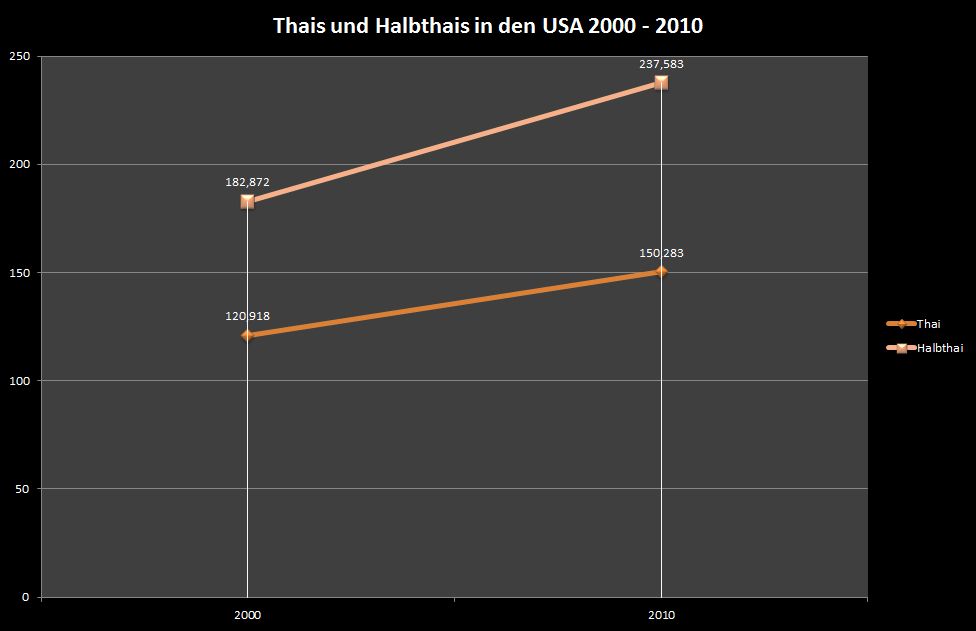
Abb.: Thais
und Halbthais in den USA 2000 - 2010
[Datenquelle: Census]
2000
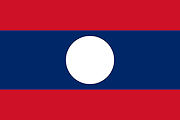
Es erscheint:
ສຸເນດ ໂພທິສານ [Souneth Photisane] ; ໜູໄຊ ພົມມະຈັນ [Nousai Phoummachan]: ປະຫວັດສາດລາວ (ດຶກດໍາບັນ-ປະຈຸບັນ) [Geschichte von Laos vom Altertum bis zur Gegenwart]. -- ວຽງຈັນ [Vientiane] : [Ministry of Information and Culture], 2000
Es ist die offizielle Geschichte von Laos, ideologisch geprägt durch Marxismus-Leninismus und historischen Materialismus.
2000
Illegale Handelswege weltweit (inklusive Menschenhandel)
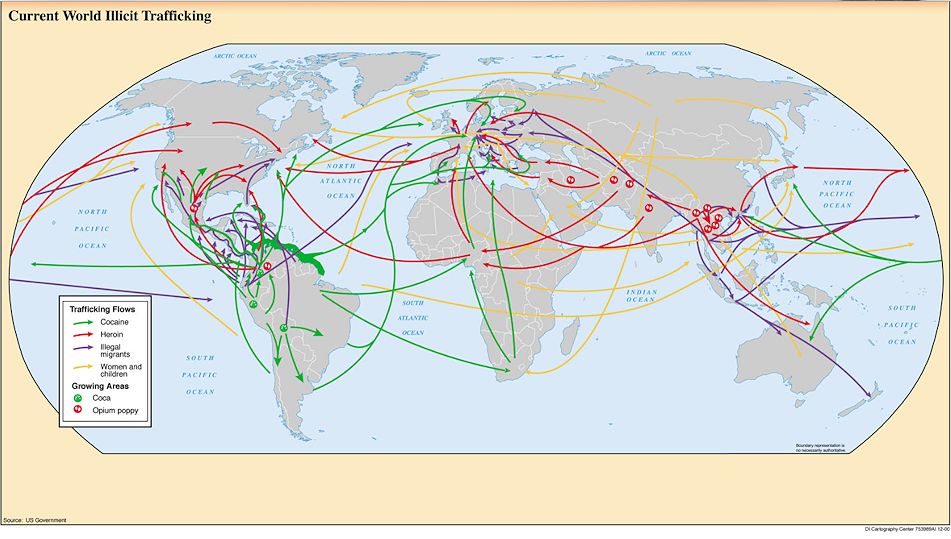
Abb.:
Illegale Handelswege weltweit (inklusive Menschenhandel) 2000
[Bildquelle:
http://waschtrommler.org/2011/04/15/menschenhandel-vor-der-haustr/. --
Zugriff am 2013-04-16. --
Creative Commons
Lizenz (Namensnennung, keine Bearbeitung)]
2000

Thailand kauft von Deutschland 20 gebrauchte Alpha Jets der Bundeswehr (Kaufpreis 39 Mio. Euro).
Abb.: "our Royal Thai Air Force (RTAF) Dornier Alpha Jet A trainers from the 231st Squadron, 23rd Wing based at Udon Thani (อุดรธานี) Royal Thai Air Force Base (RTAFB), taxi on the runway at Korat RTAFB, Thailand, during exercise "Cope Tiger 2003" on 26 February 2003. The RTAF operates 20 Alpha Jets bought from Germany in 2000.", 2003
[Bildquelle: SSgt Cecilio M. Ricardo Jr., USAF / Wikimedia. -- Public domain]
Abb.: Rüstungsexporte der Bundesrepublik Deutschland nach Thailand (in Mio. Euro)
[Datenquelle: Rüstungsexportberichte der Bundesregierung]
2000
Stadtbevölkerung
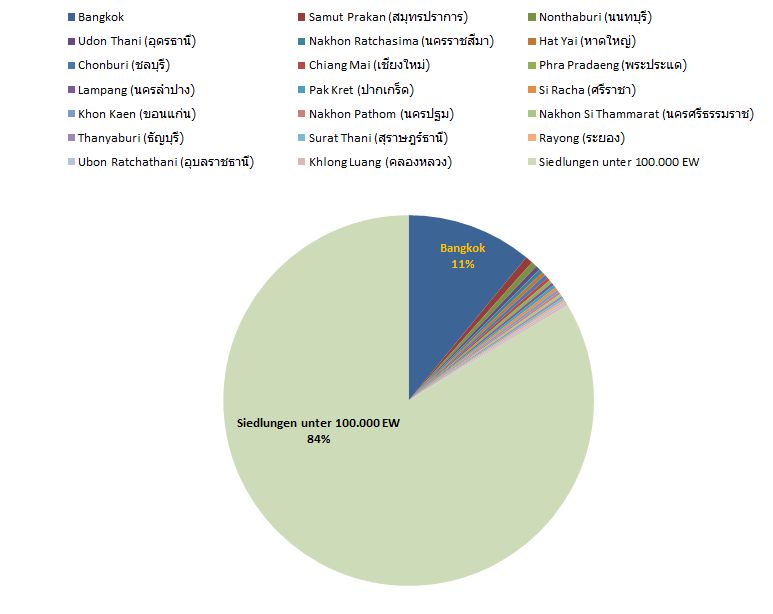
Abb.: Bevölkerung Thailands in Städten über 100.000 Einwohnern und Siedlungen unter 100.000
Einwohner, Volkszählung 2000
[Datenquelle: Fischer Weltalmanach 2012]
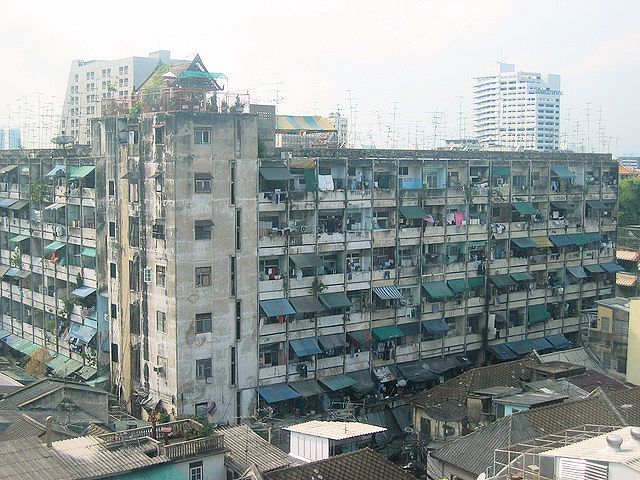
Abb.: Appartementblock, Bangkok, 2005
[Bildquelle: Kyle Simourd. --
http://www.flickr.com/photos/89241789@N00/153299767/. -- Zugriff am
2012-02-21. --
Creative Commons Lizenz (Namensnennung)]
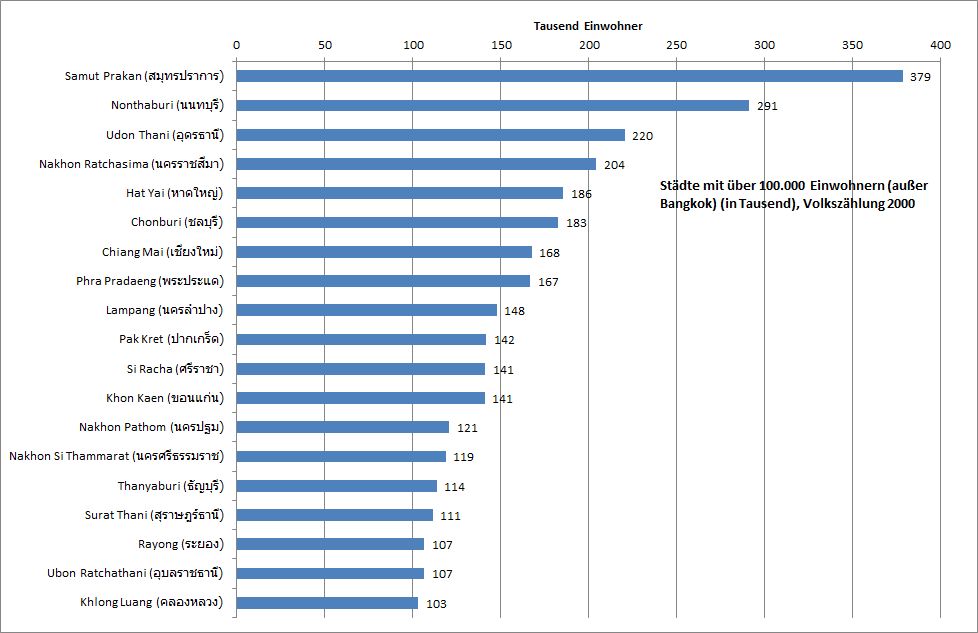
Abb.: Städte über 100.000 Einwohner (außer Bangkok), Volkszählung 2000
[Datenquelle: Fischer Weltalmanach 2012]
2000
Energiequelle zum Kochen:
Abb.: Energiequelle zum Kochen, Volkszählung 2000
[Datenquelle: National Statistical Office Thailand]
Abb.: Gas ist die beliebteste Energiequelle zum Kochen, Dorf bei Ranong (ระนอง), 2005
[Bildquelle: Ted Ollikkala. -- http://www.flickr.com/photos/teducation/12473994/. -- Zugriff am 2012-02-20. -- Creative Commons Lizenz (Namensnennung, keine kommerzielle Nutzung, share alike)]
Abb.: Lage der Provinz Ranong (ระนอง)
[Bildquelle: OpenStreetMap. -- Creative Commons Lizenz (Namensnennung, share alike)]
2000
Methoden der Geburtenkontrolle:
Abb.: Methoden der Geburtenkontrolle verheirateter Frauen 2000
[Bildquelle: http://www.searo.who.int/LinkFiles/Family_Planning_Fact_Sheets_thailand.pdf. -- Zugriff am 2011-11-29]
Abb.: Trends der Mittel zur Empfängnisverhütung 1987 - 2000
[Bildquelle: http://www.searo.who.int/LinkFiles/Family_Planning_Fact_Sheets_thailand.pdf. -- Zugriff am 2011-11-29]
Abb.: Unterweisung im Gebrauch von Kondomen, Südthailand
[Bildquelle: Wellcome Images. -- Creative Commons Lizenz (Namensnennung, keine kommerzielle Nutzung, keine Bearbeitung)]
2000 - 2011
Thailand bleibt konstant eines der korruptesten Länder der Welt.
Abb.: Corruption Perception Index von Transparency International für Thailand 2000 bis 2011
(Bestmögliche Punktezahl: 10 = keinerlei Korruption)
Abb.: Auch Buddhas Lehren verhindern Thailands verheerende Korruption nicht: 14th International Anticorruption Conference, Bangkok, 2010
Auf den Tafeln sind u. a. Buddhas fünf Trainingspunkte der Sittlichkeit dargestellt
[Bildquelle: Raymond June. -- http://www.flickr.com/photos/raymondjune/5166539886/. -- Zugriff am 2012-02-20. -- Creative Commons Lizenz (Namensnennung, keine Bearbeitung)]
2000
Die Armee zerstört die Dienstvilla eines hohen Offiziers, da diese den Insassen Unglück gebracht habe. Der Bau einer neuen Dienstvilla kostet US$125.000.
2000
Inbetriebnahme des 39.000 km langen Meeres-Glasfaser-Kabelsystems SEA-ME-WE 3 (South-East Asia - Middle East - Western Europe 3)
Abb.: Verlauf von SEA-ME-WE 3
[Bildquelle: J. P. Lon / Wikipedia. -- GNU FDLicense]
2000
Erstmals werden die Energy Awards des Department of Alternative Energy Development and Efficiency (DEDE) unter dem Ministry of Energy vergeben.
2000
Wichtigste Comics-Verleger:
2000
Beliebte japanische Comics:
 Detective Conan (名探偵コナン) |
 GTO (Great Teacher Onizuka - グレート・ティーチャー・オニヅカ) |
 Love Hina (ラブ ひな) |
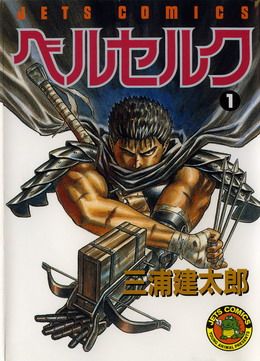 Berserk (ベルセルク) |
|
Einbandtitel [Quelle aller Abb.: Wikipedia. -- Fair use] |
|
2000
Erste Nummer des Comics Joe the SEA-CRET Agent (นักสืบโจ หัวปลาหมึก) von สุทธิชาติ ศราภัยวานิช.
Abb.: Joe the SEA-CRET Agent (นักสืบโจ หัวปลาหมึก)
[Bildquelle: Chung / th.Wikipedia. -- Creative Commons Lizenz (Namensnennung, share alike)]
2000
Es erscheint der Roman อมตะ von วิมล ไทรนิ่มนวล (1955 - )
Englische Übersetzung: Wimon Sainimnuan [วิมล ไทรนิ่มนวล] <1955 - >: Amata. -- -- [Übers.: Marcel Barang]. -- Internet edition [for Kindle]. -- 2009. -- ISBN 97 8611 7107 252. -- Originaltitel: อมตะ (2000)
2002
Die Regierung kündigt an, Koh Chang (เกาะช้าง) zu einem Tourismusziel für wohlbetuchte Touristen zu entwickeln.
Abb.: Lage von Koh Chang (เกาะช้าง)
[Bildquelle: OpenStreetMap. -- Creative Commons Lizenz (Namensnennung, share alike)]
Abb.: Koh Chang (เกาะช้าง), 2014
[Bildquelle: lab604. -- http://www.flickr.com/photos/lab604/12481840653. -- Zugriff am 2014-10-15. -- Creative Commons Lizenz (Namensnennung, keine kommerzielle Nutzung, share alike)]
2000
Gründung des Save Koh Tao Club zur Rettung des "Taucherparadieses" Ko Tao (เกาะเต่า).
Abb.: Lage von Ko Tao (เกาะเต่า)
[Bildquelle: OpenStreetMap. -- Creative Commons Lizenz (Namensnennung, share alike)]
2000
Auf Channel 7 erscheint in 20 Folgen die Soap Opera
นายฮ้อยทมิฬ ["Der brutale Wasserbüffel-Cowboy"]
Nach dem gleichnamigen Roman (1977) von Khamphun Bunthawi (คำพูน บุญทวี, 1928 - 2003). Die Serie wird ein Desaster, da Zentralthai-Schauspieler versuchen ihre Sprache wie Isan-Lao (ภาษาลาวอีสาน) klingen zu lassen.
Abb.: DVD-Cover
2000
Das Musiklabel Grammy Gold (แกรมมี่โกลด์) behauptet, dass vom folgenden Album mehr als 1 Mio. Kassetten verkauft wurden:
ไมค์ ภิรมย์พร [Mike Phiramphon] <1970 - >: ยาใจคนจน [Herzensbalsam der Armen]. -- Erschienen 1998-07-30
Das Album auf Spotify:
URI: spotify:album:2nGEprfyrC4eXYuMxhg34h
URL: https://open.spotify.com/album/2nGEprfyrC4eXYuMxhg34h
Abb.: CD-Hülle
[Fair use]
2000
Gründung der Bangkok Opera (บางกอกโอเปร่า).
Abb.: Richard Wagner: Rheingold, Bangkok Opera (บางกอกโอเปร่า), 2006-04-07
[Bildquelle: Wikipedia. -- Public domain]
"Die Bangkok Opera (in Thai: บางกอกโอเปร่า ) wurde im Jahr 2000 auf Initiative des thailändisch-amerikanischen Dirigenten und Komponisten Somtow Sucharitkul (* 1952; in Thai: สมเถา สุจริตกุล ) – sein Künstlername als Literat (er schrieb etliche erfolgreiche Science-Fiction- und Horrorromane) ist S. P. Somtow, die amerikanisierte Umstellung seines vollständigen Namens Somtow Papinian Sucharitkul – als freie und unabhängige Operncompagnie (ohne staatliche oder städtische Zuschüsse) gegründet. Gründung und Auftrag
Anfänglich ging es lediglich darum, Somtows eigenes Bühnenwerk mit dem Titel Madana zur Uraufführung zu bringen – die erste abendfüllende Oper eines thailändischen Komponisten überhaupt. Nach der erfolgreichen Produktion des Stücks im Februar 2001 wurde die Idee geboren, einen regelmäßigen Opernspielplan mit Eigenproduktionen für Bangkok aufzustellen. Da man aber weder über ein eigenes Gebäude noch über ein festes Ensemble verfügte, schloss man sich wiederum nur für gemeinsame Einzelprojekte zusammen. Das 2002 von Somtow gegründete und geleitete Siam Philharmonic Orchestra jedenfalls (das sich nach mehreren anderer erst 2004 diesen Namen gab) bildete eine wichtige Grundlage für die Überlegung hinsichtlich regelmäßiger Opernproduktionen in der thailändischen Hauptstadt.
2002 setzte die Bangkok Opera ihre ehrgeizige Arbeit unter der künstlerischen Leitung von Somtow Sucharitkul mit einer Produktion von Purcells Dido and Aeneas fort, und erarbeitete danach auch "schwergewichtigere" Werke wie Mozarts Zauberflöte oder Puccinis Turandot. Im Januar 2003 stand mit der Oper Mae Naak wieder ein Bühnenwerk Somtows auf dem Spielplan. – Die Produktionen werden hier jeweils immer in einer Serie und gewöhnlich zwei- bis dreimal gegeben.
Nach diesen eher vereinzelten Produktionen der ersten Jahre wurde für die Spielzeit 2005/06 (zwischen September 2005 und Juni 2006) eine erste vollständige Opernsaison angekündigt – übrigens das erste Vorhaben dieser Art in der ganzen Region Südostasien! Man hatte sich vorgenommen, insgesamt fünf Eigenproduktionen auf die Bühne zu bringen, darunter – neben zwei Wiederaufnahmen und einer internationalen Koproduktion – auch zwei Neuinszenierungen. Die Saison beinhaltete unter anderem die erste asiatische Eigenproduktion eines Bühnenwerks von Richard Wagner – Das Rheingold –, vorgesehen als Auftakt zu einer Gesamtproduktion des kompletten Ring des Nibelungen, die in den nachfolgenden Jahren ergänzt und dann im Jahre 2010 als vollständiger Zyklus gezeigt werden soll (die Walküre, lange im Voraus angekündigt für den 24. und 26. Juli 2007, wurde inzwischen aufgrund einer ernsten Erkrankung Somtows auf den 30. November und 2. Dezember 2007 verschoben).
Für die Opern- und Konzertproduktionen, die in Zusammenarbeit mit dem Siam Philharmonic Orchestra und dem Orpheus Choir of Bangkok (letzterer unter der Leitung von Karen TenBrink) entstehen, wird jeweils ein Ensemble aus internationalen und/oder auf internationalen Bühnen erfolgreichen thailändischen Sängern engagiert. Die Vorstellungen finden zumeist im großen Saal des Thailand Cultural Centre in Bangkok statt. – Inzwischen gesellten sich auch das Bangkok Baroque Ensemble (unter Leitung von Trisdee na Patalung; das neu gegründete Barockorchester trat im Oktober 2005 erstmals auf) und das Musica Ficta Vocal Consort (unter Somtow Sucharitkul) zu den regelmäßig an den Opern- und Konzertproduktionen der Bangkok Opera mitwirkenden Klangkörpern.
Eine regelmäßige Zusammenarbeit mit ähnlichen Compagnien – der Singapore Lyric Opera und der Lyric Opera Malaysia in Kuala Lumpur – wurde mit dem zum Mozartjahr 2006 in allen drei Metropolen abgehaltenen Mozart-Fest ins Leben gerufen. Inzwischen haben sich die drei Unternehmen und ihre Direktoren zu einer sogenannten ASEAN Opera League zusammengeschlossen, um ihre Produktionen koordinieren und gegebenenfalls auch auszutauschen zu können.
Kultureller HintergrundDie Klassische Musik des Westens hat in Thailand (im Gegensatz etwa zu Japan) keine Tradition. Hier hält man sinfonisch besetzte Filmmusik, wie sie aus den auch in den hiesigen Kinos beliebten Hollywood-Produktionen bekannt ist, für klassische Musik. Das Interesse von Königin Sirikit an der Oper äußerte sich in gelegentlichen Gastspielen anlässlich ihres Geburtstags (ähnlich, wie selbst das rege Engagement des Königs Bhumibol Adulyadej für den Jazz – er spielte früher selbst Saxophon und komponierte etliche Standards – diesem in Thailand nicht zu einer bemerkenswerten Popularität verhelfen konnte). Klassische Musik wurde fast ausschließlich von Expats nach Thailand mitgebracht. Die inzwischen – allerdings fast ausschließlich in der Hauptstadt Bangkok – vorhandenen Orchester und Chöre sind sämtlich Laienensembles, die von engagierten Expats gegründet und geleitet werden, und die sich auch zum überwiegenden Teil aus Ausländern zusammensetzen. Das zu einem überwiegenden Teil mit Thais besetzte Siam Philharmonic Orchestra (oder auch das Thailand Philharmonic Orchestra) ist ebenso eine Ausnahme, wie das Engagement eines thailändischen Musikers für die Oper. Auch gibt es in ganzen Land bislang nur eine einzige Ausbildungsstätte für Klassische Musik: das College of Music der Mahidol University (มหาวิทยาลัยมหิดล)[1] in Salaya in der Provinz Nakhon Pathom (นครปฐม), deren Lehrer und Studenten sich zum Thailand Philharmonic Orchestra[2] zusammengeschlossen haben.
Vor diesem Hintergrund ist das Engagement der Bangkok Opera zu sehen, die ohne Kooperationen mit westlichen Künstlern und ohne ein westliches Publikum – bestehend aus in Thailand lebenden Ausländern (die das Vorhaben auch finanziell und ideell unterstützen) und (Kultur-)Touristen – nicht existieren könnte. Die beiden Vorstellungen des Rheingold im Februar 2006 (also noch zur besten Reisezeit) fanden beispielsweise vor einem halbleeren Saal statt – wogegen die Musiksprache der Bühnenwerke Somtows in ihrer Melange aus Musicalelementen und Filmmusik die Thais (und weiteres asiatisches Publikum) eher anzuziehen und anzusprechen vermochte.
Produktionen der Bangkok Opera (Auswahl) 20012002
- Somtow Sucharitkul (* 1952): Madana [มัทนพาธา][3] – die Oper, mit deren Komposition Somtow 1999 beauftragt worden war, wurde im Februar 2001 uraufgeführt. Sie basiert auf einem märchenhaften Stück, das König Vajiravudh (Rama VI.) geschrieben und seiner Gemahlin, Königin Indrasaksachi, gewidmet hatte, welche auch die Großtante des Komponisten war. Die Titelrolle wurde von der amerikanischen Sopranistin Stacey Tappan interpretiert
2003
- Henry Purcell: Dido and Aeneas
Spielzeit 2004/05
- Somtow Sucharitkul: Mae Naak (แม่นาก) – Somtows zweite Oper über ein thailändisches Sujet erlebte ihre Uraufführung am 6. Januar 2003. Sie basiert auf Thailands bekanntester Geistergeschichte Mae Naak (oder Nak) Prakanong, die bereits unzählige Male verfilmt wurde – am bekanntesten davon dürfte die filmische Adaption von Nonzee Nimibutr sein, die den Titel Nang Nak trägt. Die chinesisch-britische Sopranistin Nancy Yuen sang die Titelrolle – sowohl in der Premiere, als auch in der Wiederaufnahme im September 2005
- Johannes Brahms: Ein deutsches Requiem (thailändische Erstaufführung) – Gedenkkonzert für den im Januar 2000 in Karatschi (Pakistan) ermordeten Journalisten Daniel Pearl
- Benjamin Britten: The Turn of the Screw
- Wolfgang Amadeus Mozart: Die Zauberflöte
Spielzeit 2005/06
- Wolfgang Amadeus Mozart: Don Giovanni
- Giacomo Puccini: Turandot
- Giuseppe Verdi: Aida - in der Inszenierung von Richard Harrell
Spielzeit 2006/07
- Somtow Sucharitkul: Mae Naak – als Wiederaufnahme aus dem Jahr 2003 (mit diesem Stück wurde die Saison am 3. September 2005 eröffnet)
- Richard Wagner: Das Rheingold – die erste asiatische Eigenproduktion eines Wagnerschen Bühnenwerks (5. und 6. Februar 2006)
- Giacomo Puccini: Madama Butterfly – Gastspiel der Singapore Lyric Opera in einer Inszenierung des singapurer Schauspielers und Regisseurs Ivan Heng und mit Nancy Yuen in der Titelrolle (5. und 6. April 2006)
- Wolfgang Amadeus Mozart: Die Zauberflöte – Wiederaufnahme aus dem Jahr 2004 anlässlich des Mozartjahres 2006
- Wolfgang Amadeus Mozart: Così fan tutte – Neuinszenierung von Richard Harrell (Premiere am 25. Juni 2006)
Spielzeit 2007/08
- Somtow Sucharitkul: Ayodhya (อโยธยา) – die dritte Oper des thailändischen Komponisten, welturaufgeführt am 16., 18. und 19. November 2006, basiert auf einer Episode des Ramayana. In der Inszenierung von Hans Nieuwenhuis, die als Kooperation zwischen der Bangkok Opera und dem Opera Studio Nederland[4] zustande kam, sangen unter anderem der englische Countertenor Michael Chance, Nancy Yuen, Charles Hens und John Ames. Die Produktion war zur 60sten Jubiläum der Thronbesteigung des Königs komponiert worden, die in diesem Jahr ausgiebigst gefeiert wurde. Wegen kritischer Äußerungen Somtows zum Militärputsch vom 19. September und den geschassten Premierminister Thaksin Shinawatra wurde die Produktion von der Übergangsregierung zensiert[5][6]
- Benjamin Britten: The Rape of Lucretia (24., 25. und 26. Februar 2007)
- Henry Purcell: Dido and Aeneas – Wiederaufnahme von 2002 (7., 8. und 9. April 2007)
- Giacomo Puccini: Madama Butterfly – Neuinszenierung von Henry Akina mit Nancy Yuen in der Titelrolle (29. und 31. August 2007)
- Richard Wagner: Die Walküre – Neuinszenierung mit Janny Zomer, Charles Hens und Barbara Smith-Jones (30. November und 2. Dezember 2007). Die ursprünglich für diese Termine vorgesehene Uraufführung von Somtows neuer (vierter) Oper Dan no Ura wurde ins Jahr 2008 verschoben"
[Quelle: http://de.wikipedia.org/wiki/Bangkok_Opera. -- Zugriff am 2012-06-06]
2000/2001
Richard Lair und der Komponist Dave Soldier gründen das Thai Elephant Orchestra im National Elephant Institute in Amphoe Hang Chat (ห้างฉัตร), Provinz Lampang (ลำปาง).
Die Gruppe auf Spotify:
URI: spotify:artist:2Nf3f8upG12pcASfitfk0P
URL: https://open.spotify.com/artist/2Nf3f8upG12pcASfitfk0P
Abb.: Lage des Thai Elephant Orchestra
[Bildquelle: OpenStreetMap. -- Creative Commons Lizenz (Namensnennung, share alike)]
"The Thai Elephant Orchestra is a musical ensemble consisting of as many as sixteen elephants near Lampang (ลำปาง) in Northern Thailand. The elephants play music (essentially as conducted improvisations) on enormous specially designed musical instruments. The orchestra was created and is conducted by elephant conservationist Richard Lair of the Thai Elephant Conservation Center and the American composer/performer Dave Soldier (1956 - ). They have three CDs released on the Mulatta Records label with an orchestra ranging in size from 6 in the initial CD (2001) to fourteen elephants in the last, Water Music (2011)." [Quelle: http://en.wikipedia.org/wiki/Thai_Elephant_Orchestra. -- Zugriff am 2012-06-14]
2000
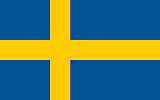
Das erste Album - ผมชื่อโจนัส ("Ich heiße Jonas") des schwedischen Luk Thung (ลูกทุ่ง) Sängers Jonas Anderson (1972 - ) wird mit über 200.000 verkauften CDs ein großer Erfolg.
Künstlerlink auf Spotify:
URI:
spotify:artist:1ymH2kfbbakk7beFKGRmUz
URL:
https://open.spotify.com/artist/1ymH2kfbbakk7beFKGRmUz

Abb.:
CD-Titel
|
"Jonas Anderson (โจนัส แอนเดอร์สัน) a Swedish singer known in Thailand[1] for singing lookthung (ลูกทุ่ง) or Thai country/folk music. He has released five solo albums so far and three duet albums with fellow non-Thai lookthung singer, Christy Gibson (คริสตี้ กิ๊บสัน). BackgroundJonas Anderson was born on August 27th, 1972. He moved to Thailand as a child with his family in August 1981. Shortly after arriving, his family moved to the North-Eastern region of Thailand (Issan - อีสาน) to engage in educational projects in rural areas. Jonas Anderson had an interest in music and singing from an early age. Growing up in Thailand he started picking up the language and learning Thai songs. When Jonas was in his teens his family moved down to Bangkok, and Jonas enrolled in a performing arts course in his late teens after which he formed a group with Christy Gibson and other friends performing for various social causes, especially drug awareness programs in schools and youth centers. Professional CareerJonas Anderson’s unlikely path to becoming a known lookthung or Thai country recording artist began when he and Christy Gibson were asked to sing a lookthung song for a community event. This experience sparked Jonas’ interest in lookthung and he started to learn and perform more of this style of music. A pivotal moment in Jonas’ career was when he was discovered by famous TV personality Khun Wittawat Suntornwinet (วิทวัส สุนทรวิเนตร์, 1954 - ), owner and host of the popular variety TV show, “At 10” or “Tee Sip” (ตีสิบ). Khun Wittawat saw Jonas singing a popular lookthung song at a New Year’s eve party and consequently invited him to appear on his show. Appearing on this nationally televised prime time television show drew public attention and interest in Jonas Anderson. This was further amplified when he featured on the country’s premier nationally televised lookthung concert called “Wetee Thai” (เวทีไท) paving the way for Jonas Anderson to launch a professional music career. He entered an intensive voice training program under lookthung master, Aniwat Phanom[2] (artist name Vilai Phanom) and finally recorded his first album, “Pom Chue Jonas” (ผมชื่อโจนัส - My Name is Jonas) which was released in June, 2000 under the Wetee Thai label. The album was an instant success selling over 200,000 copies[3] Jonas Anderson’s first album was followed by three more albums under Wetee Thai after which he was signed by Sony Music Thailand where he released one more solo album and his first duet album with Christy Gibson. After that he released a seventh album (his second duet album) under the Mangpong label. His eighth album is one that he and Christy produced and released independently. Along with his recording and touring career, Jonas Anderson co-hosted a television program with Christy Gibson on Channel 3 (Thailand) (ช่องสาม) called Thung Banterng." [Quelle: http://en.wikipedia.org/wiki/Jonas_Anderson. -- Zugriff am 2013-04-08] |
2000
Gründung der Hip-Hop-Band Thaitanium (ไทยเทเนี่ยม)
Die Gruppe auf Spotify:
URI:
spotify:artist:3FGnh8UxybIGIkiNnyF3CS
URL:
https://open.spotify.com/artist/3FGnh8UxybIGIkiNnyF3CS
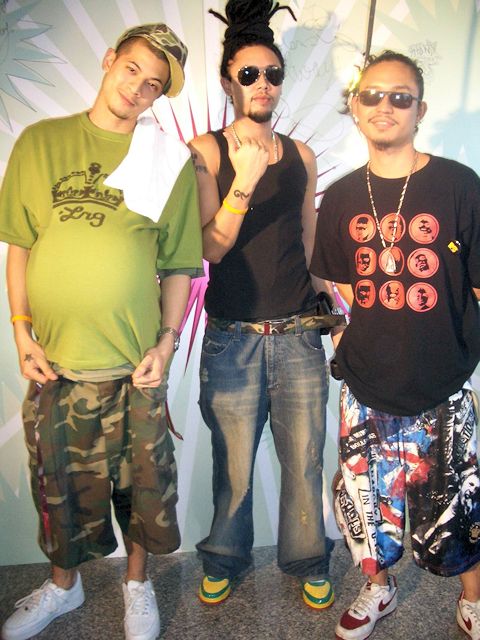
Abb.:
Thaitanium (ไทยเทเนี่ยม)
[Bildquelle:
Sry85 / Wikipedia. -- GNU FDLicense]
|
Thaitanium (Thai: ไทยเทเนี่ยม) is a Thai-American hip hop music group. Among the first of Thai rap artists, the group formed in 2000 by K.H. - Khanngoen "Khan" Nuanual (ขันเงิน เนื้อนวล - ขัน, 1976 - ), P. Cess - Prinya "Way" Intachai (ปริญญา อินทชัย - เวย์, 1981 - ), Sunny Day - Nay Myo "Day" Thant (จำรัส ทัศนละวาด - เดย์, 1976 - ). The group has released five albums and has performed for the MTV Asia Awards and was an opening act for 50 Cent (1975 - ) and Snoop Dogg, as Justice was absent from the Together Festival 2013 in Bangkok. Group historySouth-Side Phuket-born (ภูเก็ต) Kan attended university in the United States in the late 1990s and became part of the rap and hip hop house party scene in San Francisco. At around the same time, a New York City-born Thai rapper, Day had moved to Thailand and was trying to start a rap scene in Thailand. When Khan and Day returned to Thailand, they met Way and Thaitanium was formed. Their first two albums, AA and Thai Riders, were produced and recorded in New York City, and released in Thailand in 2000 and 2002. Subsequent album releases cemented the group's popularity in Thailand, where it was played in night clubs, bars and at music festivals. The group also performed the soundtrack to the Thai film Province 77, (จังหวัด 77) about Thai people living in Los Angeles. Thaitanium was featured on "Dangerous", a track by Thai pop singer Tata Young (ทาทา ยัง, 1980 - ) in 2005. The group performed at the 2006 MTV Asia Awards, joining Simon Webbe (1978 - ) in a performance of "No Worries."[1] The group also opened for Fort Minor and 50 Cent in a concert in February 2006 at Aktiv Square, Mueang Thong Thani in Bangkok. The group then released its fifth album, Thailand's Most Wanted, and supported it with its first solo concert, "MTV Live: Thaitanium Uncensored" in 15 November 2006 at BEC-TERO Hall. Thaitanium come to concert in many countries such as USA. , England, Australia, Laos, Singapore, Indonesia and Malaysia. Thaitanium have feat. With M-Flo from Japan, project tom yum sa mu rai with Yushiro Tanaka now this album be on sale in Japan. Now Thaitanium invite Nas that is the best of the hip hop band from USA. To change their experience. Currently the Thaitanium members are working on other projects beside their music, Khun and Day's started his own clothing line called "9Face", Way and DJ.Buddha's as well has also started his own called "Never Say Cutz" and "Reven" Thaitanium's new Album called "Still Resisting" was released on June 8, 2010. It includes hit songs such as "Long Loey (หลงเลย) [Feat. แบงค์ Clash & สิงห์ Sqweez Animal]," and "Yapper" ProfileKhaneng Nuenuan or Khan or King of Da Hustle birth on 4 September 1976. His hobbies are listening to music, read a book. Style of music that he likes are hip hop, Rap, Jazz, Reggae. Favorite sports are Basketball and Skateboard. If Khan doesn’t be singer he will be the songwriter. Jumrut Tutsanalawat or Day or Sunny Day. Birth on 25 September 1976. Day also have Burmese race. His hobby is listening to music.Styles of music that he likes are hip hop and Jazz. Favorite sports are Basketball and Skateboard. If Day doesn’t be singer he will be estate agent. Prinya Intachai or Way or P CESS. Birth on 10 January 1981. His hobbies are playing sport and listening to music. Style of music that he likes is hip hop. Favorite sport is Basketball.Way want to be the actor. Now Way married with Nana Rybena , Now Nana is pregnant with twins for 3 months." [Quelle: http://en.wikipedia.org/wiki/Thaitanium. -- Original Thai-Englisch] |
2000
Gründung der Rockband Slot Machine (สล็อต แมชชีน)
Die Gruppe auf Spotify:
URI:
spotify:artist:6TNTFjkJA8PhP16Ds7CZnz
URL:
https://open.spotify.com/artist/6TNTFjkJA8PhP16Ds7CZnz
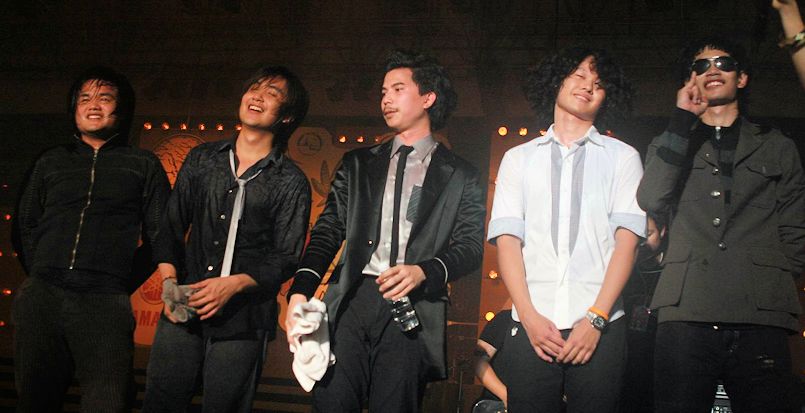
Abb.: Slot
Machine (สล็อต แมชชีน), 2007
[Bildquelle: Sry85 / Wikipedia. --
Creative Commons
Lizenz (Namensnennung)]
"Slot Machine (สล็อต แมชชีน) is a rock band from Bangkok, Thailand. They record on the Sony BMG label. They were awarded Song of the Year for "ผ่าน" ("Pan") at the Seed Awards held in January 2007,[1] having also been nominated for Rock Album of the Year, Rock Artist of the Year and Music Video of the Year."
[Quelle: http://en.wikipedia.org/wiki/Slot_Machine_%28band%29. -- Zugriff am 2013-04-08]
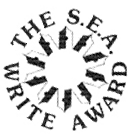
Wimon Sainimnuan (วิมล ไทรนิ่มนวล, 1955 - ) erhält den Southeast Asian Writers Award für den Roman อมตะ
Abb.: Einbandtitel einer der Ausgaben
2000
Fünf Tage vor der geplanten Eröffnung verbietet die Chulalongkorn University (จุฬาลงกรณ์มหาวิทยาลัย) eine Ausstellung des Visual-Künstlers Vasan Sitthiket (วสันต์ สิทธิเขตต์). Die Bilder zeigten Thai Politiker und Militärs in sexuell komprimittierenden Posen.
Abb.: Vasan Sitthiket (วสันต์ สิทธิเขตต์), 2008
[Bildquelle: 2T / Wikipedia. -- GNU FDLicense]
"Vasan Sitthiket (Thai: วสันต์ สิทธิเขตต์), born on October 7, 1957 in Nakhon Sawan Province (นครสวรรค์), Thailand is a Thai contemporary visual artist. A graduate of the College of Fine Art in Bangkok, he has works in many fields, including painting and poetry. He has staged three plays, written more than 10 books of poetry, children’s books and political writings. Works
Active since the 1970s, Vasan's works are often provocative and political in nature. One of his works was a performance art piece, involving fake rubber breasts and buttocks and a simulated rape of the entire nation of Thailand.[1]
In 2000, an exhibition of a new collection that included 50 paintings featuring Thai politicians and military officers in sexually compromising poses was cancelled by Chulalongkorn University, five days before it was to open.[2]
In 2005, he set up the Artist Party (พรรคศิลปิน), a political art project that mocked the then-ruling Thai Rak Thai party and prime minister Thaksin Shinawatra.[3]
At the 50th Venice Biennale in 2003, he displayed some large-scale portraits of George W. Bush and other world leaders, created on canvas by using custom-made rubber stamps.[4]
Vasan's media has also included drawings, woodcut prints, ceramic sculpture, installations and performances.
Vasan exhibited at Thavibu Gallery in 2009 - Capitalism is Dying!"
[Quelle: http://en.wikipedia.org/wiki/Vasan_Sitthiket. -- Zugriff am 2012-06-16]
2000


Es erscheint:
Tuck, Lily: Siam or The Woman who shot a Man : a novel. -- Woodstock : Overlook, 1999.. -- 192 S. -- (Sewanee Writers' Series). -- ISBN 978-0879517236. -- Der Roman spielt in Thailand 1967 während des Vietnamkriegs.
Abb.: Einbandtitel
2000

Sieger in der Thai Premier League (ไทยพรีเมียร์ลีก) (Fußball): BEC Tero Sasana F. C. (สโมสรฟุตบอลบีอีซี เทโรศาสน)
Abb.: ®Logo
[Bildquelle: Wikipedia]
2000
Architekt Nithi Sthapitanonda (นิธิ สถาปิตานนท์) (1947 - ): Fertigstellung des Resorts
- Ban Rimtai, Mae Rim (อำเภอแม่ริม), Chiang Mai (เชียงใหม่)
2000
Briefmarken:
ausführlich: http://www.payer.de/thailandchronik/ressourcen.htm
Zu Chronik 2000 / B. E. 2543. -- 2. Januar bis Juni